 |
|
| Organizzazione | Expert choice |
| Link al sito | www.expertchoice.com |
| Categoria di appartenenza del sito: | Societą di software |
| Nazione o Regione/Provincia | USA |
| Outline del sito | Welcome to Expert Choice. Our solutions ensure that organizations make accurate decisions that are aligned with their strategic business objectives. With Expert Choice's software, consulting and training, your organization will turn abstract goals into concrete actions. The process is painless and proven to lead to faster, better, more justifiable decisions. |
| Contenuti del sito |
| The Software and Methodology That Has Changed How Decisions Are Made
No business succeeds without the ability to identify strategic objectives and then execute them. The concept is simple. Reality, however, is chaotic: The larger the organization, the more complex the considerations, the more elusive the right choices become. Human elements and volumes of data multiply into a universe of nebulous intangibles, many completely irrelevant to the bottom line. This path leads to a costly process producing insecure decisions.
As an alternative, imagine this: Every person involved in your decision process gets to contribute their fair input. Every project gets individual consideration. The result is your organization's most accurate priorities and the means to achieve them are bold bottom lines everyone can read. Essentially, the process is no longer painful. And it works.
Expert Choice is a group meta decision support software product based on the world’s most successful decision-making methodology, the Analytic Hierarchy Process (AHP). Expert Choice enables you to leverage the expertise and collective wisdom of your team for more informed and justifiable decisions.
Expert Choice is the decision-making approach that is most intuitive for you and your team to:
• Facilitate identification of your objectives
• Facilitate identification of a full range of alternative solutions
• Evaluate key trade-offs among your objectives and alternatives
• Walk away with a decision that is fully understood and supported by your team.
Expert Choice is the world’s most popular decision-making method because it adapts to your decision-making style and situation through a flexible, model structuring interface. You can choose to build your decision model from a top-down perspective, that starts by helping you to gain a deep understanding of your goals and objectives. You can also use a bottom-up approach to leverage your expertise by using Expert Choice to list the pros and cons of your decision alternatives, and then use patented Expert Choice technology to easily transform these pros and cons into identifiable and quantifiable decision objectives and goals.
The patented and proven Expert Choice method works by guiding decision-makers through a series of pairwise comparisons to derive priorities for decision objectives and options. You can incorporate any type of quantitative and qualitative performance data into your decision-making process with Expert Choice. Data conversion utilities can convert raw performance data about your alternatives to priorities. The benefit is that the organization can leverage large amounts of data along with judgments and intuition to make more informed decisions.
Expert Choice lets you combine and synthesize the judgments of any subset of decision-makers or the entire group to provide the full spectrum of different perceptions of a problem.
There are five sensitivity (what-if) graphs that dynamically test scenarios to see how changing the weight of an objective affects a outcome of the decision.
Reporting and notes features let you document your results by allowing you to link or embed any type of supporting quantitative or qualitative information.
|
Expert Choice Four Step Decision Making Process
1) Drag and Drop Model Structuring
Expert Choice’s Structuring is a freestyle, interactive technique for building a model that simulates the flow of ideas, and helps decision-makers organize the objectives of their decision into theme clusters.
Top-Down Structuring: An individual or group brainstorms and clusters objectives using an affinity diagraming white-board. The clusters of objectives and sub-objectives become a decision hierarchy to be used for prioritization and evaluation of alternatives.
Bottom-up Structuring: Decision-makers begin by listing a set of candidate alternatives and their pros and cons. The pros and cons are converted to objectives and clustered to form your decision hierarchy.
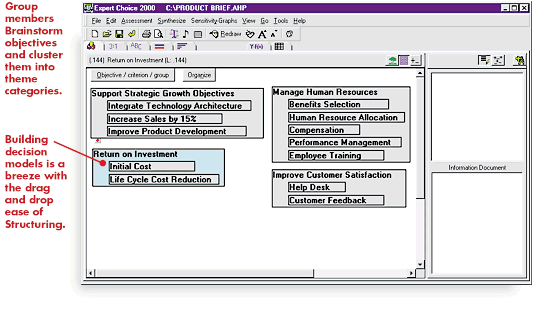
2) Prioritizing Objectives using Pairwise Comparisons
Expert Choice uses the pairwise comparison process to develop priorities for decision objectives and alternatives. Group judgments can be entered using radio frequency keypads or remotely via the Internet. Following are the three ways to make pairwise comparisons:
Verbal: Decision-makers compare objectives for their relative importance
and alternatives for their relative preferences using the following words: Equal, Moderate, Strong, Very Strong and Extreme.
Numerical: A nine point numerical scale is used to define the relative importance of your decision variables.
Graphical: Judgments are made by adjusting the relative length of two bars until the bars represent how much more important one element is to the other.
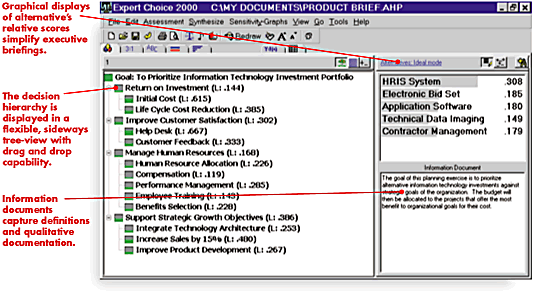
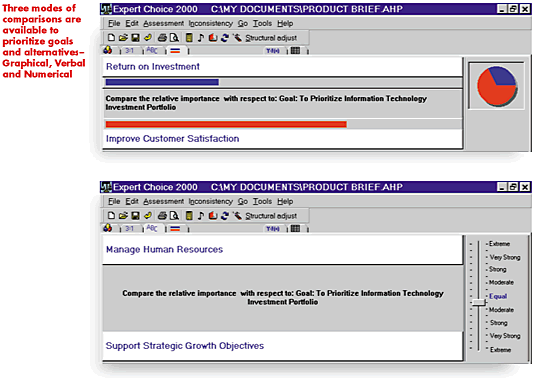
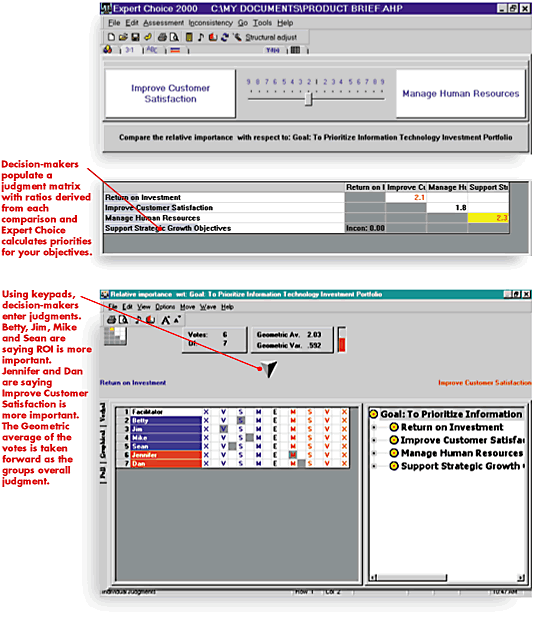
3) Evaluation of Alternatives
Once the objectives have been prioritized, Expert Choice provides several ways to evaluate the alternatives.
1. By using one of the three pairwise modes described above to compare the alternatives for their preferability with respect to each objective, or
2. By using the Data Grid feature to create one of the following scales to prioritize each alternative.
a. Ratings – Used when you want to "rate" alternatives using intensities such as Excellent, Very Good, Good, Fair and Poor. This is often the case for subjective aspects of an evaluation or when there is no hard data. Pairwise comparisons are used to develop ratio scale priorities for the rating intensities.
Use the following features when you have data about the alternatives.
b. Step Functions – A Step Function is similar to Ratings in that it consists of a scale of prioritized intensities. However, the Step Function translates the data into the appropriate rating intensity for each alternative.
c. Utility Curves –Utility curves translate data into priorities. Whereas the Step Function consists of discrete steps, a Utility Curve is continuous.
d. Direct – Use this to enter priorities directly.

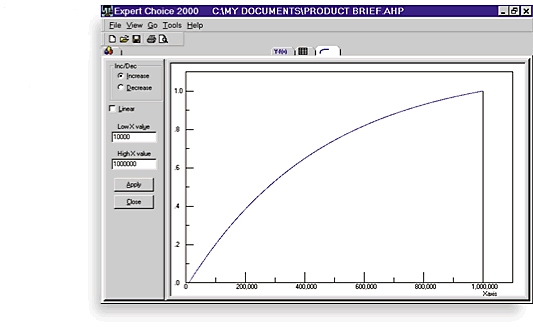

4) Sensitivity Analysis
After making judgments about the relative importance of objectives, sub-objectives and alternatives, Expert Choice’s powerful sensitivity graphs enable you to test the sensitivity of the decision to changes in priorities. These what-if scenarios are especially useful for management briefings.
Expert Choice is designed for the analysis, synthesis and justification of complex decisions and evaluations for use in individual or group settings. Different versions are available to meet your unique needs. Contact one of our sales representatives to determine the version that best meets your decision-making needs.
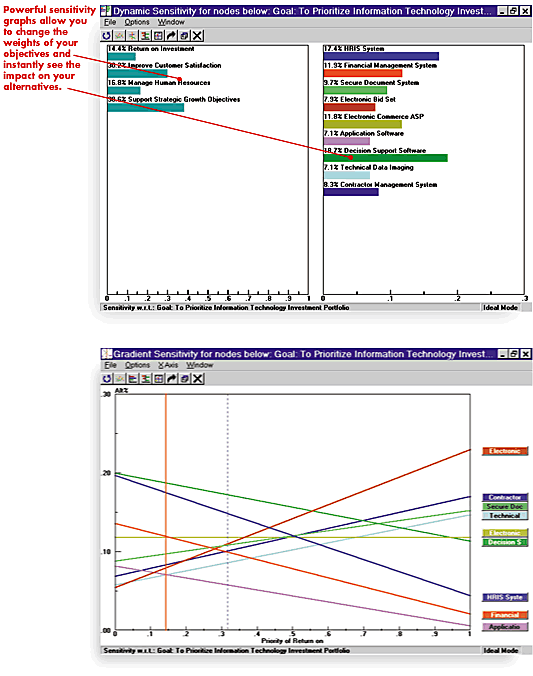
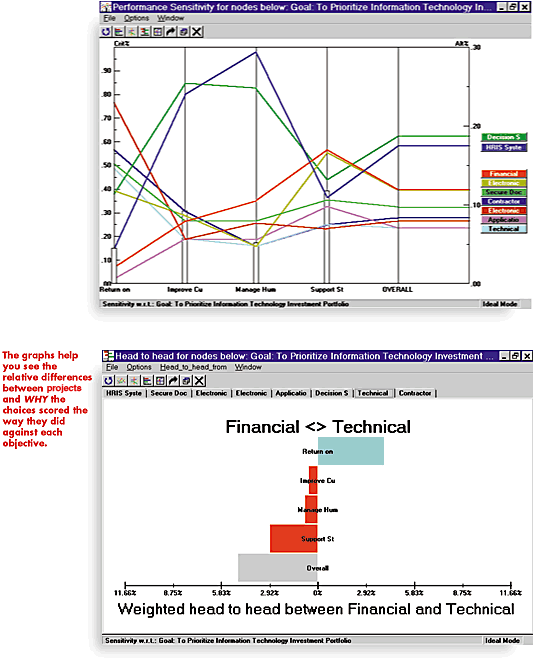
|
|
|
|
|
| |